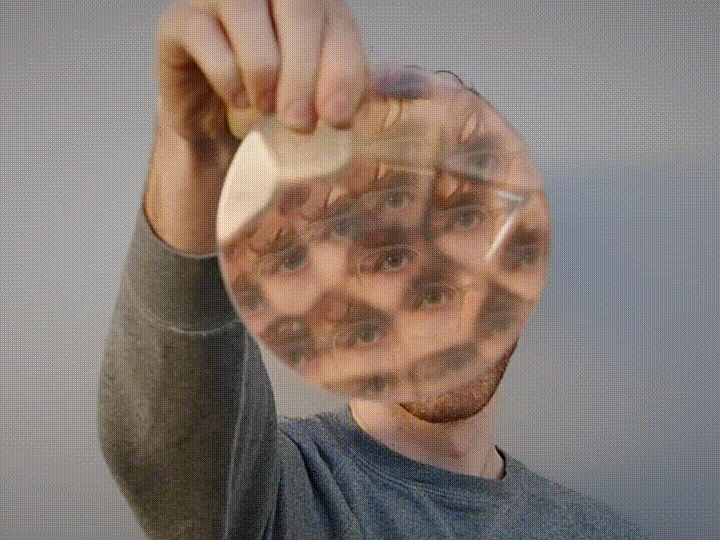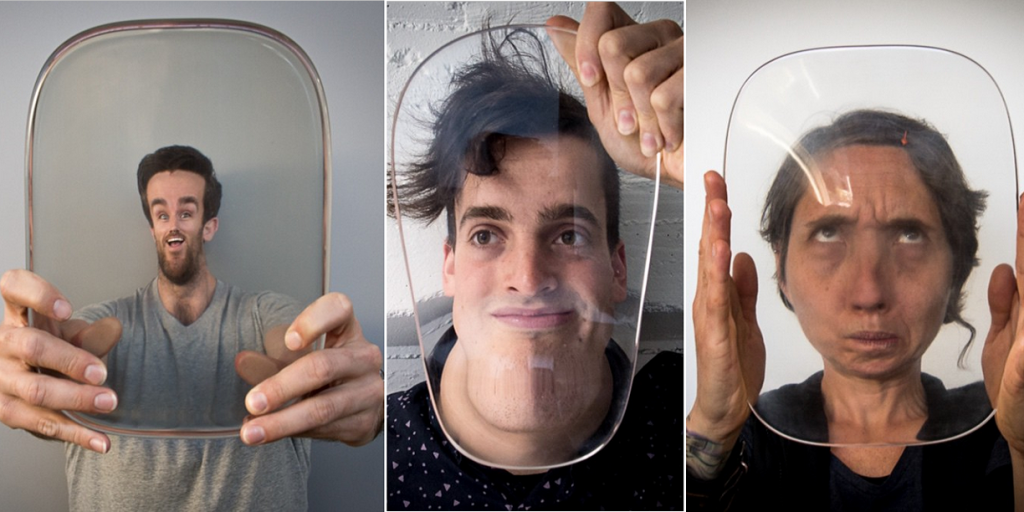![]() Anyone who has ever used or even seen an iPad at the store is likely all too familiar with the pre-installed Photobooth application which lets you take photos and view yourself with all sorts of crazy distortions. It’s the ultimate freak-show of selfie taking, and you could actually scare yourself if you aren’t too careful.
Anyone who has ever used or even seen an iPad at the store is likely all too familiar with the pre-installed Photobooth application which lets you take photos and view yourself with all sorts of crazy distortions. It’s the ultimate freak-show of selfie taking, and you could actually scare yourself if you aren’t too careful.
What if you could get the same effect, but with a simple lens instead of a $500+ Apple iPad? Well, two artists, Robb Godshaw and Max Hawkins set out to do just that, with their collection fo 3D printed customized lenses called ‘Smaller & Upside Down’.
“I made my first lens while building a projector for a robotic sculpture,” explained Godshaw on his Instructables project. “I built the sculpture’s projector assembly myself and was unable to find a projection lens that fit my requirements. Every commercially available lens was either too small or too expensive. I decided to try making my own lens instead (though I knew almost nothing about optics). I found a hunk of acrylic plastic and used a 3-axis CNC router to mill it into a lens shape. The lens cast a slightly blurry image, but it worked!”
He then turned to 3D printing to see if that would work any better. He designed the lenses first using Rhino and Neon software, although he explains that any modeling software with a ray tracing  feature would work just fine. Ray tracing allows them to get a better idea of how each lens may distort what’s behind it once it is fabricated. The other possible software programs one can use include the likes of Blender, Fusion 360, Maya, etc. Because these lenses will be created out of plastic, rather than glass, Godshaw found that the index of refraction value was different then glass, which is normally 1.52. He found that using an index of refraction of 1.63 worked best for designing for 3D printing.
feature would work just fine. Ray tracing allows them to get a better idea of how each lens may distort what’s behind it once it is fabricated. The other possible software programs one can use include the likes of Blender, Fusion 360, Maya, etc. Because these lenses will be created out of plastic, rather than glass, Godshaw found that the index of refraction value was different then glass, which is normally 1.52. He found that using an index of refraction of 1.63 worked best for designing for 3D printing.
Once they had a design they liked, they sent it off to be 3D printed. Because Godshaw himself is an Artist in Residence at Autodesk’s Pier 9 Workshop, which features a number of industrial 3D printers, they luckily had access to some of the best additive manufacturing equipment and materials in the world. Godshaw and Hawkins were able to take full advantage of the Objet Connex 500 3D printer from Stratasys to print the lenses using Stratasys’ patented VeroClear transparent resin. VeroClear is a rigid, colorless photopolymer which has a rubber-like feel to it.
According to the two men, the printing process was actually a breeze. All they had to do was press ‘print,’ leave for the night, and return in the morning to find the lenses had been fabricated. Once printed, the fun had only begun, however. Now an entire 5 hours of sanding and polishing work was required, which consisted of several rather tedious steps. In the end, however, the lenses all turned out quite well, with all sorts of facial distortions made possible.
The two men’s work, of which about half the lenses had been printed, while the other half were milled out of an acrylic plastic on a 3-axis CNC router, was on display this past weekend as part of the Market Street Prototyping Festival in San Francisco.
Which of their lenses do you like best? Check out some additional photos of their work below:
Subscribe to Our Email Newsletter
Stay up-to-date on all the latest news from the 3D printing industry and receive information and offers from third party vendors.
You May Also Like
Precision at the Microscale: UK Researchers Advance Medical Devices with BMF’s 3D Printing Tech
University of Nottingham researchers are using Boston Micro Fabrication‘s (BMF) 3D printing technology to develop medical devices that improve compatibility with human tissue. Funded by a UK grant, this project...
3D Printing Webinar and Event Roundup: April 21, 2024
It’s another busy week of webinars and events, starting with Hannover Messe in Germany and continuing with Metalcasting Congress, Chinaplas, TechBlick’s Innovation Festival, and more. Stratasys continues its advanced training...
3D Printing Webinar and Event Roundup: March 17, 2024
It’s another busy week of webinars and events, including SALMED 2024 and AM Forum in Berlin. Stratasys continues its in-person training and is offering two webinars, ASTM is holding a...
3D Printed Micro Antenna is 15% Smaller and 6X Lighter
Horizon Microtechnologies has achieved success in creating a high-frequency D-Band horn antenna through micro 3D printing. However, this achievement did not rely solely on 3D printing; it involved a combination...

































